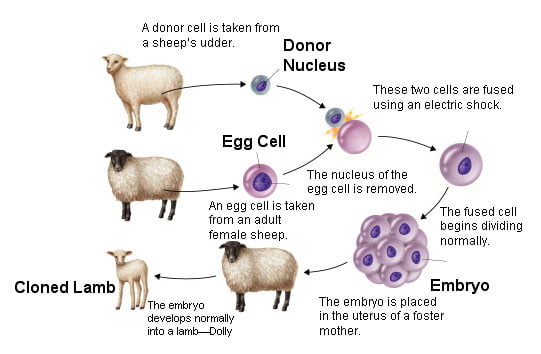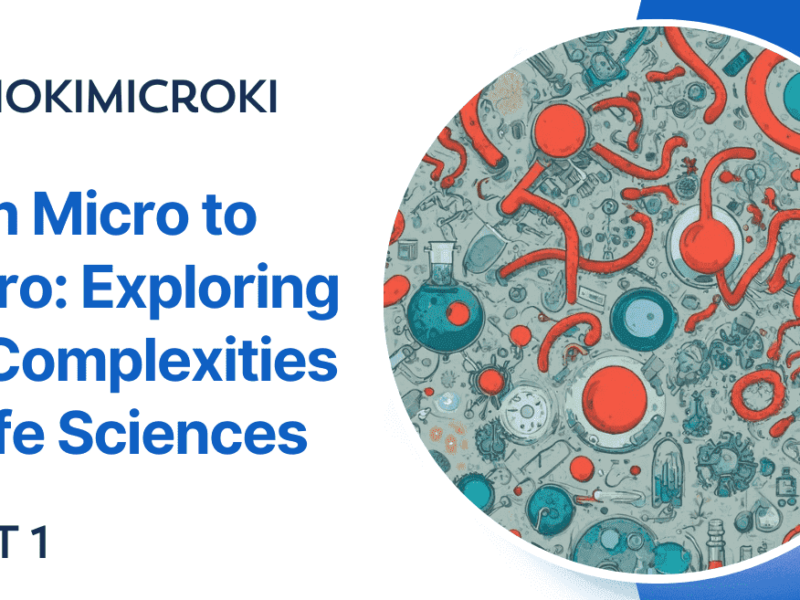Cloning is a method of producing genetically identical organism that already exist in nature. It is asexual form of reproduction. There is no involvement of male or female gametes. Binary fission is a type of natural cloning. In binary fission, the bacteria produces its clones. Cloning can also be done artificially in the laboratory. There are three types of artificial cloning –
- Reproductive cloning
- Therapeutic cloning
- DNA cloning
Reproductive cloning –
It is an intentional production of genetically identical copies of an individual. The clone contain identical genetical material and carry same set of genes. The method that is employed to obtain clones in mammals or human is by two methods – Somatic Cell Nuclear Transfer (SCNT) and embryo splitting. In SCNT method, an egg cell is enculeated (nucleus is removed). The nucleus is compensated or replaced with the somatic nucleus of an individual that needs to be cloned. The egg cell carrying the somatic nucleus is induced and stimulated to divide. It leads to series of multiplication forming a blastocyst. This blastocyst is then transferred to the uterus of the surrogate mother. If the implantation is successful, it further develops to form an animal. It takes normal gestation and birth period. This animal is the exact copy of an individual who had donated its somatic nucleus. As there is no involvement of two gametes, there is no genetic recombination.
The offspring receives mitochondria and its genes from maternal side. Hence, In SCNT, the obtained clone carries the mitochondria and its genes from the egg donor. Therefore the clone is not completely identical to the nuclear donor. If the egg donor and somatic nuclei donor is the same, then embryo receives the same genetic material of nuclei and mitochondria from a single individual.

In Embryo splitting can be done in in-vitro fertilization technique. In in-vitro fertilization, the fertilization of male and female gamete is carried out in artificial environment or laboratory. The fertilized egg i.e. zygote divides into two and then into four identical cells. During this stage, the embryo is splitted into two and allowed to form two identical blastocyst. These blastocyst are then implanted in mother’s uterus. The both blastocyst further develops to form identical twins or clones. This method is similar to the natural formation of monozygotic twins.

The clones obtained using the above method will be genetical identical but may not same behavioral characteristics. It is because the expression of genes is highly affected with the environment and nutrition. The clones may have different life experience that will shape their behavior.
What is the motive of Reproductive cloning?
- In animals, the cloning could be done to obtain best quality breed with efficient characteristics.
- In research, the animals can be clones to understand and explore fundamentals of life.
- Infertile, lesbian or gay couple can have genetical identical child to one of the parent of the couple. But there are many ethical issues on which debate is still going on.
Therapeutic cloning –
The therapeutic cloning means to obtain the clones for healing the diseases of the patient. It can be used for the treatment of organ transplant, autoimmune disease, cancer, diabetes, thyroid etc. In this technique, the whole clone body is not produced rather only required cells or tissues are developed in the laboratory. To obtain the clones for therapeutic cloning, SCNT method is employed. The same procedure is followed (as explained above) to obtain embryo. The embryo is made up of stem cells called as Embryonic Stem cells (ES cells) and they are pluritpotent in nature. Stem cells have the ability to multiply and to differentiate into different types of cells. Such stem are of different types, read here to learn about them. ES cells can be isolated at the blastocyst stage to develop cell lines. The ES cell lines can be further induced to form different types of cells or organs. These genetical identical cells can be used for therapeutic transplantation. Such research would overcome the limitation of the adult stem cells.
As the therapeutic stem cells are genetical identical, their is to use for transplantation with minimal rejection. So cloning done for therapeutic transplantation is called as therapeutic cloning.
DNA cloning –
DNA/Gene cloning in Molecular Biology and Genetic Engineering, it means making copies of segment of DNA or desired gene. The gene cloning can be done in live cells or in PCR. Read our article on DNA cloning to learn more about it.
References-
https://www.ncbi.nlm.nih.gov/books/NBK223960/
https://www.genome.gov/about-genomics/fact-sheets/
https://www.pnas.org/content/112/29/8879
Dr. Sangha Bijekar has 9 years of Teaching Experience at University level. She loves to get engage in teaching and learning process. She is into blogging from last two years. She intends to provide student friendly reading material. She is avid Dog Lover and animal rescuer. She is learned Bharatnatyam and Katthak Dancer. She is into biking and She also loves to cook.


